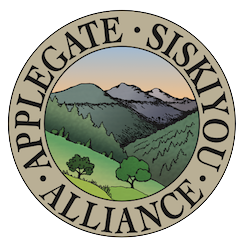With the fall weather comes the end of the public land grazing season on the Siskiyou Crest. Fall is a good time to go out and monitor the impact of grazing allotments on the public lands of the Siskiyou Crest, including the headwaters of the Applegate River, located on the northern slope of the Siskiyou Crest. The area is filled with sensitive wetlands, meadows, seeps, springs, and headwater streams that become heavily damaged each season by unmanaged cattle, utilizing what the agency calls “passive season long grazing.”
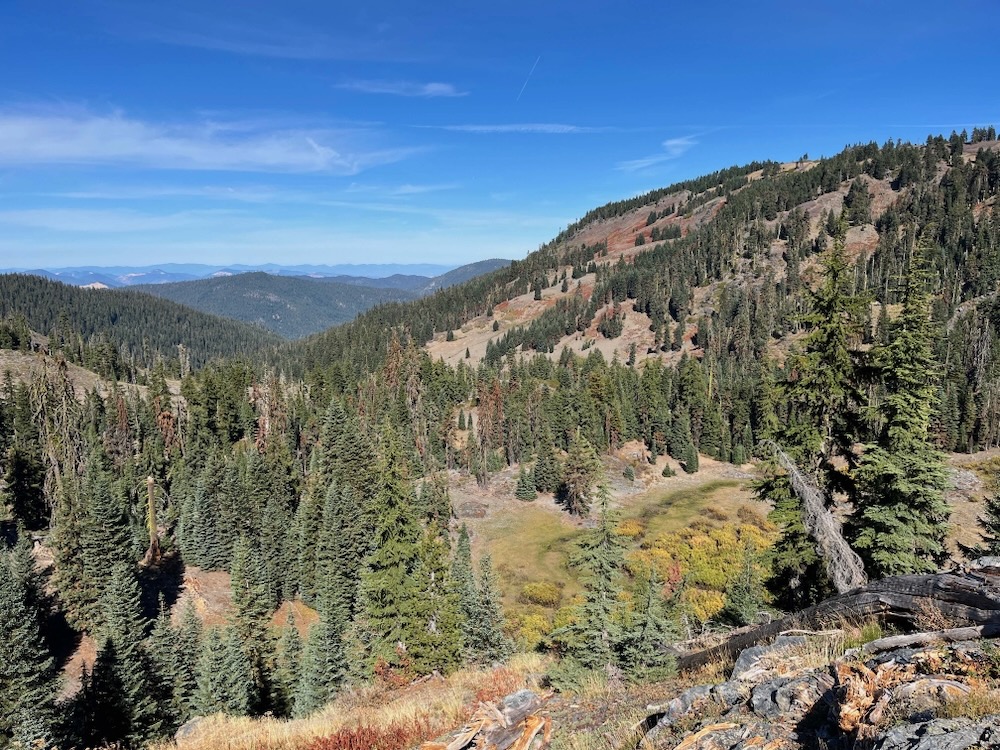
What this means is that cattle are dropped off in the spring and allowed to forage largely unmanaged throughout the grazing season, congregating in wetlands and meadows, along streams and other areas that are sensitive to livestock grazing. The result is the degradation of water quality, impacts to the spongy headwater basins that support water flows during the summer in the Applegate River, damage to willow wetlands, trampling of streambanks, the lowering of water tables, impacts to native vegetation, impacts to wildlife habitat, and increased competition between cattle and native grazing species such as elk and deer.
Each summer there are at least 10 active grazing allotments on the Siskiyou Crest on both the Rogue River-Siskiyou National Forest and the Klamath National Forest, and although stocking levels may change from year to year, there can be up to 2,000 cows permitted on the different allotments on the Siskiyou Crest each year, resulting in long-term ecological impacts.

The Forest Service often claims that historic overgrazing is responsible for the dramatic impacts we see today. Although historic grazing impacts were severe all across the eastern Siskiyou Crest in the historic era, these effects are compounded and reinforced by the overgrazing that continues to occur on public land grazing allotments to this day.
This past October, we visited the Silver Fork Basin in the Beaver-Silver Allotment and Alex Hole basin in the Upper Elliott Allotment, two of the most overgrazed meadow systems and headwater basins in the Applegate River watershed and on the eastern Siskiyou Crest. We found both areas heavily overgrazed.
Watch ASA’s new video about public land grazing on the Siskiyou Crest.
In particular, we found Alex Hole and the surrounding meadows heavily trampled and “over utilized,” meaning palatable vegetation had been eaten down to the nub, precluding both flower production and seed production for many species. Denuded to ground-level, the meadows and streams in the Alex Hole basin support almost no forage for native ungulates such as deer and elk, and cannot provide stream shade due to heavy browsing by cattle in the summer and fall.
Earlier this summer we had visited Alex Hole on the second day of grazing season and found it to have already been significantly overgrazed, just two days into the season, meaning the cows had been there before they were permitted to be there.
Currently riparian habitats throughout the watershed within federal grazing allotments are collapsing, streams are downcutting, noxious or non-native weeds are spreading, and native riparian vegetation, such as willow, is being denuded across entire stream reaches. Waterways and springs are also filled with cow excrement, and deep “punching” where cattle hooves sink deep (6″-10″) into moist soils, damaging wetlands, seeps, springs and streams through excessive trampling, excessive soil disturbance, damage to native vegetation, hydrological impacts, downcutting and the slow, steady de-watering of these habitats through the compounding impacts.
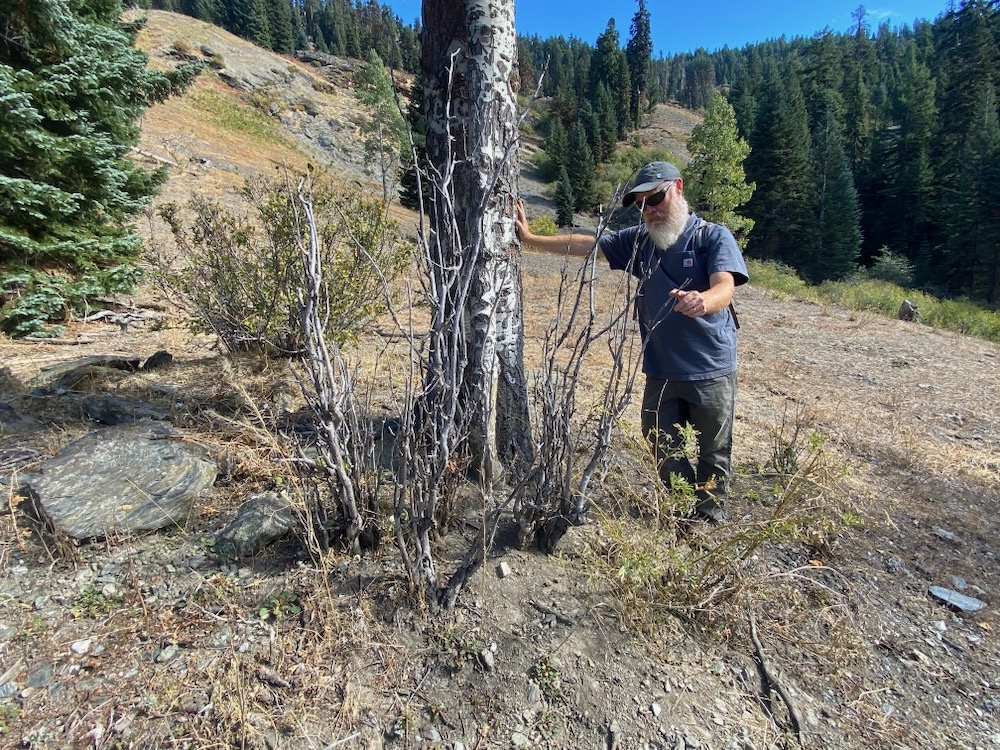
In many favored grazing sites, cattle have eaten sedges, grasses and other herbaceous species to the ground, leaving little for wildlife, including deer and elk that also forage on these same native plants and in these same native plant communities. Additionally, aspen habitats have been heavily impacted on Alex Creek, including some of the region’s only tree-form aspen stands which are now heavily degraded, unable to regenerate, and slowly dying out due to extreme and continuous grazing impacts to aspen groves on Alex Creek.
Numerous sensitive wildlife species, such as the willow flycatcher, a small song bird that utilizes mature willow stands for nesting and foraging are also being impacted by overgrazing on the Siskiyou Crest at the Applegate’s headwaters. Willow flycatcher habitat requires dense, continuous willow stands, which are heavily fragmented by cows within the tiered meadow system of the Alex Hole basin, as well as in Silver Fork basin, and in some areas the willows have been entirely extirpated from specific stream reaches due to heavy trampling and grazing.
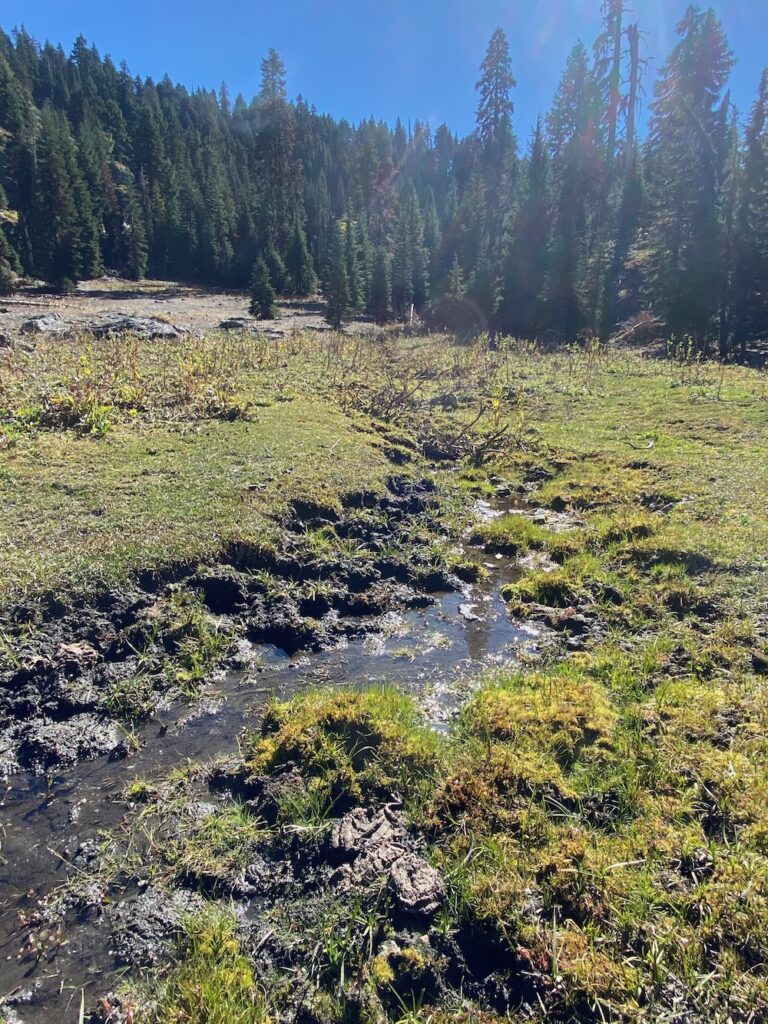
Sensitive species like the Sierra Nevada blue butterfly utilize the high elevation alpine shooting stars (Dodecatheon alpinum) as a larval host plant; however, cattle trample these larvae, eat the larvae while gazing, and target shooting star flowers and stalks as a favored species to eat early in the season. This precludes flower production and seed production of alpine shooting stars, limiting the geographic extent of this species and hindering its natural regeneration process, thereby impacting the ability of the Sierra Nevada blue butterfly to live in these meadows because they can’t complete their lifecycles without their larval host plant.
In fact, the federal livestock grazing program is heavily subsidized by the public. In 2015 resource economists studied the costs of livestock grazing on public lands. They found that the federal lands grazing program generated $125 million less than what the federal government spent on the program in 2014. Further, they found that federal grazing fees are 93 percent less than fees charged for non-irrigated Western private grazing land, or just $1.69 per animal per month for each cow and calf that grazes the public land. It costs more to feed a house cat, and this year’s fees are even less — in 2024 the fee was a paltry $1.35.

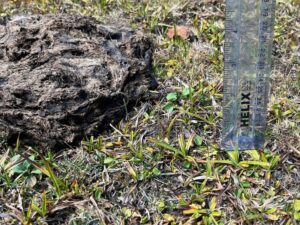
Public land grazing has many impacts, both contemporary and historic, but the negative effects of current public land grazing practices are clear to see on the Siskiyou Crest. These public lands contain important biological, recreational, scenic, and watershed values; yet, they are being managed as private feedlots, for federal grazing permittees, who both benefit from and significantly impact federal lands. Who does not benefit is the public, who is forced to socialize both the costs and impacts of this management.
Please help us bring public land grazing in the Applegate into the 21st century. This begins first and foremost, with the Siskiyou Mountains Ranger District completing an Environmental Impact Statement for all grazing allotments in the Applegate, utilizing the best available modern science and research. It also begins with your advocacy, asking Forest Service managers to adopt and implement site specific Best Management Practices (BMPs) for each grazing allotment, along with publicly available Annual Operating Instructions (AOIs), that:
- Incorporates the new mandates of the North Coast Water Quality Control Board that now requires Annual Operating Instructions (AOI) for all federal grazing allotments within its management area, including the headwater streams of the Applegate on the Siskiyou Crest. The Rogue River-Siskiyou National Forest must comply with the Clean Water Act management requirements adopted by the North Coast Water Board in its Federal lands Permit.
- Requires electronic (virtual) fencing for cattle on the Siskiyou Crest to allow land managers to better track their location, manage their movements, document cattle “drift” or trespass into unauthorized areas, and to help reduce impacts to sensitive habitats and species by herding cattle that congregate in specific habitats, especially wet meadows and rare plant populations.
- Mandates site specific BMPs the grazing permit holder must implement to prevent unacceptable levels of water quality, riparian and wetland degradation, including but not limited to, instructions on rotating grazing among different areas, and the frequency and type of herding needed to avoid unacceptable levels of degradation.
- Requires the agency to commit to a number of monitoring visits to each allotment on an annual basis. The agency should document the number of times and time periods that Forest Service staff will check each allotment to verify that the required grazing management actions specified in the AOI are being adequately implemented.
- Requires mitigation in basins and watersheds that are listed as “impaired” due to sediment, water temperature or nutrient conditions. Mitigation measures should require at least a year of rest for watersheds in which the annual Multiple Indicator Monitoring (MIM) reading finds bank disturbance equal to or greater than 10%.
- Mandates protections for rare and unusual plant species and Botanical Areas on the Siskiyou Crest, including both sensitive plants and unique plant communities like quaking aspen stands.
- Mandates protections for the Pacific Crest Trail, its trail side camps, water sources, and scenery.
- Requires additional protections and mitigation measures that benefit wildlife, including deer and elk.
Some of the local grazing allotments have not been meaningfully reviewed or received updates to their management plans since 1964, clearly it is time for an update and a shift towards more a modern, responsible approach to federal land management. The current management plans are badly outdated and the allotments are badly damaging habitats.
Finally, any new management plans developed by the the Rogue River-Siskiyou National Forests should allow buyout options for federal grazing allotments and permits. This would allow grazing allotments to be publicly bought out and retired to protect and restore the biological, scenic and recreational values of the Siskiyou Crest region.
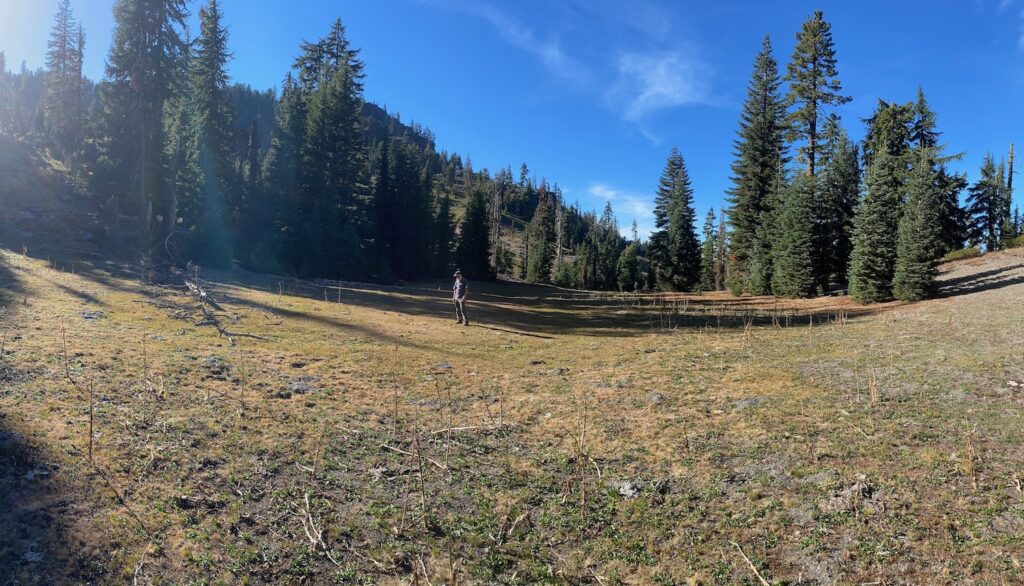
With both a warming climate and a looming biodiversity crisis, we should be protecting, not trampling and degrading our headwater streams. We should also be protecting our rare plant populations and designated Botanical Areas, our native pollinators, wildlife and aquatic species from unnecessary degradation. The current grazing program has significant impacts to the land, no benefit to American taxpayers, and acts as a subsidy for specific economic interests and individual families who benefit financially from the massive handouts, and leaves behind significant impacts for the public to address.
Contact the following Forest Service employees and help us support the many important values of the Siskiyou Crest. Our public lands should be managed as far more than a feedlot for private grazing interests!
Contact the following Forest Service employees with your concerns surrounding the public land grazing program and your support for updates to grazing management plans in the Applegate River watershed and in the spectacular high elevation habitats of the Siskiyou Crest.
Forest Supervisor Molly Juillerat: molly.juillerat@usda.gov
District Ranger Jen Sanborn: Jennifer.Sanborn@usda.gov
Impacts from public land grazing allotments aren’t limited to Forest Service land in the Applegate, they happen on BLM land too. Additionally, contact Senator Wyden’s office and tell him not to cosponsor the Operational Flexibility Grazing Management Program Act (S.4454, 118th Congress), which would remove the administrative control the BLM has over the grazing of livestock on 155 million acres of federal public lands. The Applegate has one grazing allotment on BLM land, the Lower Big Applegate Alloment, that could be affected by this legislation, but the impacts to BLM land throughout the West would be huge if this legislation passes.
From Andy Kerr’s blog post: Wyden’s Unilateral Public Lands Livestock Grazing Giveaway
Senator Ron Wyden (D-OR) is the sole cosponsor of a bill by Senator John Barrasso (R-WY) that would give Bureau of Land Management (BLM) grazing permittees and lessees even more free rein than they have now to (ab)use the public lands. The Barrasso-Wyden bill, the Operational Flexibility Grazing Management Program Act (S.4454, 118th Congress), would effectively remove any administrative control the BLM has over the grazing of livestock on 155 million acres of federal public lands.
Andy Kerr
